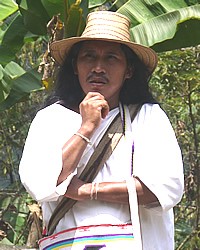Kogi in Colombia

Photo Source:
Uhkabu - Wikimedia
Creative Commons
|
Send Joshua Project a map of this people group.
|
| People Name: | Kogi |
| Country: | Colombia |
| 10/40 Window: | No |
| Population: | 21,000 |
| World Population: | 21,000 |
| Primary Language: | Kogi |
| Primary Religion: | Ethnic Religions |
| Christian Adherents: | 1.60 % |
| Evangelicals: | 1.60 % |
| Scripture: | New Testament |
| Ministry Resources: | Yes |
| Jesus Film: | No |
| Audio Recordings: | Yes |
| People Cluster: | South American Indigenous |
| Affinity Bloc: | Latin-Caribbean Americans |
| Progress Level: |
|
Introduction / History
In the Sierra Nevada de Santa Marta of Colombia there lives a group of people named Kogi, existing somewhat closely to the way they did before Christopher Columbus arrived in the hemisphere. Their name means "jaguar" in their language. When Caribs invaded around 1000, they fled to the mountains. Their location there led to the retention of their way of life but also preserved them from the Spanish invasion.
What Are Their Lives Like?
The Kogi create their own clothing from plant to finished product. Nearly everyone wears these white clothes. They live in round huts made with stone, mud, and palm leaves. Kogi men and women all carry traditional bags, made by the women, across their shoulders.
They cultivate sugar and coffee to sell. The sugar is made into a hardened brown substance.
There is a meeting hut exclusively for the men where community decisions are made. Mamas or priests are very important to the decision-making process.
Kogi women are seldom mistreated and are valued as being very connected to Mother Earth. When two men meet, they exchange handfuls of coca leaves.
What Are Their Beliefs?
Aluna or "The Great Mother" is their deity. She is the earth who is alive. A nearby mountain is known as "The Heart of the World" and the Kogi are the "Elder Brothers" who care for it. They see nature as needing protection and oppose the mistreatment of it.
Mamas are village priests who undergo strict training. Selected male children train in a dark cave for the first nine years of their lives. Mamas and the child's mother care for these young priests inside the cave until they are ready to begin their practice in the society. It is believed that the mama can hear the words of their god to pass along to the tribe.
The Kogi believe in complementary opposites. Even wrong doing is necessary as the complement to right.
After death a soul is considered to be on a journey for nine days and nights, after which it returns to an existence alongside the living Kogi.
What Are Their Needs?
The Kogi people need the spiritual hunger it will take to embrace the empty grave and follow Christ will all their hearts.
Prayer Points
Pray for a spiritual hunger that will drive them to the only savior.
Pray for a Disciple Making Movement to spread far and wide in Colombia.